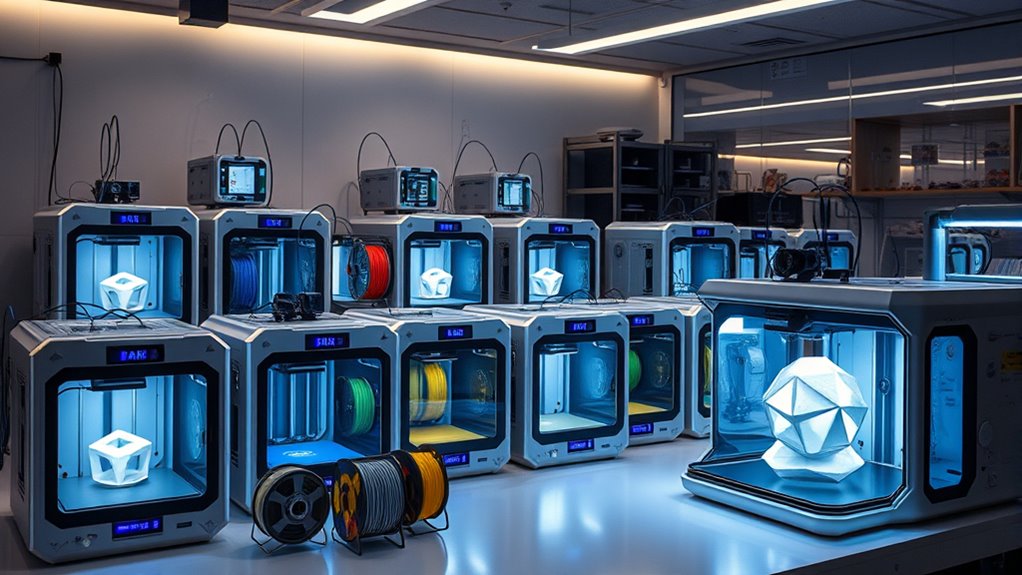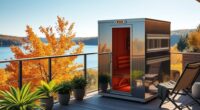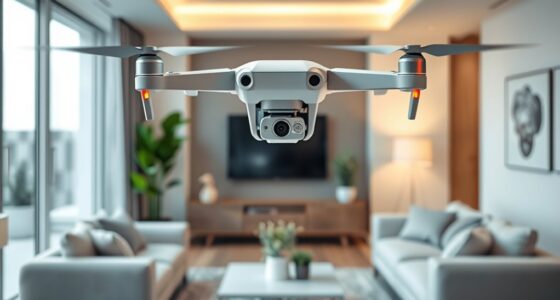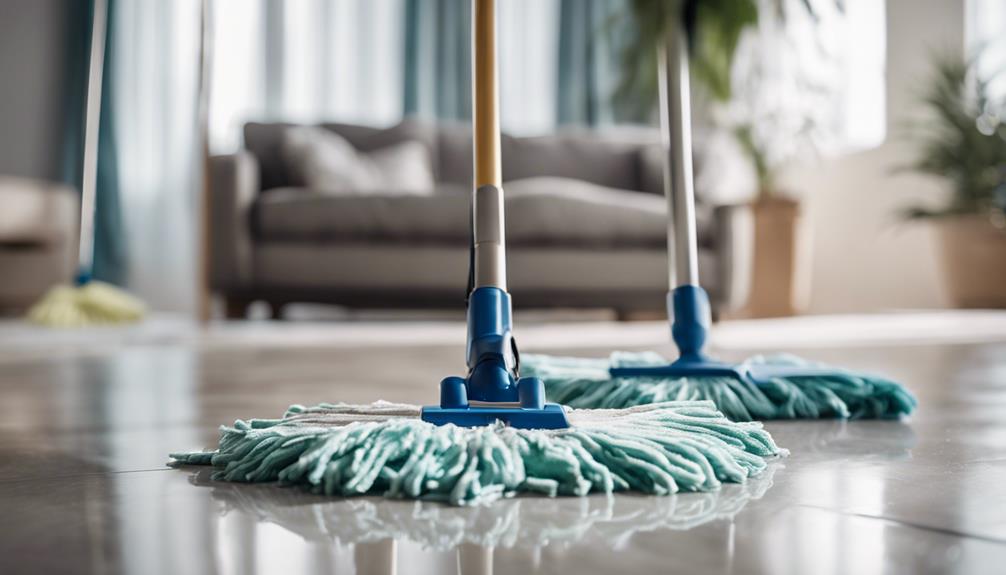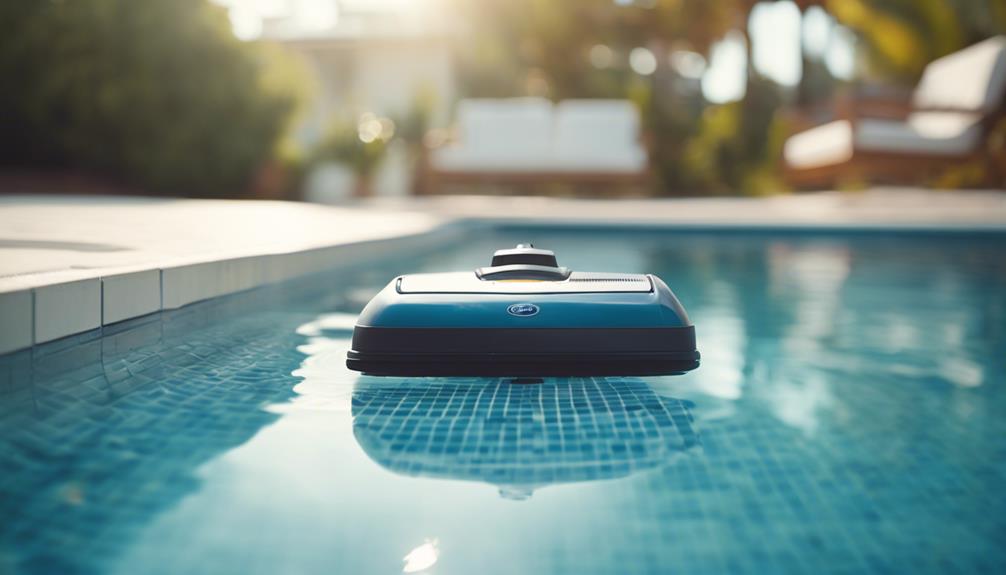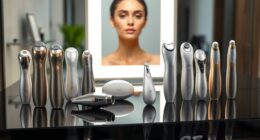If you’re exploring the best 3D printers of 2025 for creativity and precision, I recommend checking out models like the FlashForge Adventurer 5M, QIDI MAX3, and ELEGOO Neptune 3 Pro. These printers offer high speed, large build volumes, and versatile materials perfect for both hobbies and professional work. For more options tailored to your needs, keep going—you’ll find plenty of innovative choices that can elevate your 3D printing projects.
Key Takeaways
- The list features top 3D printers designed for high accuracy, speed, and creative versatility in 2025.
- It includes models suitable for hobbyists, educators, and professional manufacturers.
- Key features encompass automatic bed leveling, large build volumes, and advanced filament support.
- The selection highlights user-friendly operation, remote control apps, and safety features.
- Innovative designs like multi-material and multi-color capabilities enhance creative and functional printing projects.
FLASHFORGE Adventurer 5M 3D Printer
If you’re looking for a 3D printer that combines ease of use with high-speed performance, the FlashForge Adventurer 5M is a top pick. It features one-click automatic printing with seamless bed leveling, ensuring perfect first layers every time. The quick 3-second nozzle change and 35-second warm-up make setup effortless. Thanks to its Core XY structure, it reaches speeds up to 600mm/s and accelerates to 20,000mm/s², enabling rapid prototyping. The dual-fan nozzles, vibration compensation, and versatile nozzle sizes guarantee high-quality, detailed prints. Plus, the integrated mobile app allows remote monitoring, keeping you in control at all times.
Best For: hobbyists, educators, and small-scale manufacturers seeking high-speed, user-friendly 3D printing with professional-quality results.
Pros:
- One-click automatic printing with seamless bed leveling for easy setup
- Achieves rapid speeds up to 600mm/s and high acceleration for efficient production
- Versatile nozzle sizes and dual-fan nozzles ensure detailed, high-quality prints
Cons:
- Regular maintenance like nozzle and platform cleaning is necessary for optimal performance
- The high-speed operation may require careful calibration to maintain print accuracy
- Advanced features and remote monitoring may have a learning curve for beginners
QIDI MAX3 3D Printer
The QIDI MAX3 3D Printer stands out for its massive build volume and high-speed capabilities, making it an ideal choice for professionals and serious enthusiasts who need to produce large or multiple parts efficiently. Its large workspace (12.8×12.8×12.4 inches) and printing speeds up to 600mm/s enable fast, precise fabrication of complex models. The fully assembled, auto-leveling all-metal frame, heated chamber, and dual cooling fans ensure stability and consistent quality. Supporting a wide range of materials, including high-performance filaments like PA12-CF and PET-CF, it’s versatile for prototypes, artistic pieces, or functional parts. Its user-friendly software and responsive support make it a top contender in 2025’s 3D printing landscape.
Best For: professionals and serious enthusiasts seeking fast, large-scale 3D printing with high precision and versatile material support.
Pros:
- Huge build volume (12.8×12.8×12.4 inches) for large or multiple parts
- High-speed printing up to 600mm/s with reliable accuracy
- Supports a wide range of materials, including high-performance filaments like PA12-CF and PET-CF
Cons:
- Initial assembly issues such as tight-fitting parts and manufacturing defects
- Limited multi-material and multi-color printing capabilities
- Requires proper filament storage and calibration for optimal print quality
ELEGOO Neptune 3 Pro FDM 3D Printer
The ELEGOO Neptune 3 Pro stands out as an excellent choice for hobbyists and small-scale professionals seeking reliable, high-quality 3D printing. Its 225x225x280mm build volume suits a variety of projects, and the pre-assembled components allow for quick setup. The removable touchscreen makes operation straightforward, while the dual-geared SUS303 stainless steel extruder ensures smooth filament feeding and reduces clogging. With auto bed leveling that scans 36 points, it maintains consistent print quality on uneven surfaces. Dual Z-axis lead screws and silent stepper motors provide stability and quiet operation. Overall, the Neptune 3 Pro combines precision, convenience, and versatility for impressive 3D printing results.
Best For: hobbyists and small-scale professionals seeking a reliable, easy-to-assemble 3D printer with high-quality results and versatile filament compatibility.
Pros:
- Easy setup with pre-assembled components and a removable touchscreen for intuitive operation
- Reliable auto bed leveling with 36-point scanning for consistent print quality on uneven surfaces
- Quiet operation due to silent stepper motors and efficient cooling system
Cons:
- Limited build volume compared to some larger 3D printers
- May require manual adjustments for complex or large-scale projects
- Slightly higher cost than entry-level 3D printers with fewer features
FLASHFORGE Adventurer 5M 3D Printer
For anyone seeking a 3D printer that combines speed, ease of use, and high-quality results, the FlashForge Adventurer 5M stands out as a top choice. It features one-click automatic printing with seamless bed leveling, ensuring flawless first layers and reliable adhesion. Its quick 3-second nozzle change and 35-second warm-up to 200°C make setup effortless. With a Core XY structure, it reaches speeds up to 600mm/s, enabling rapid prototyping. The dual-fan nozzles, vibration compensation, and multiple nozzle sizes deliver detailed, precise prints. Plus, the integrated mobile app allows real-time remote monitoring, making high-speed, professional-quality 3D printing accessible for all skill levels.
Best For: hobbyists, educators, and professionals seeking fast, reliable, and high-quality 3D printing with minimal setup and user-friendly features.
Pros:
- One-click automatic bed leveling and seamless setup for easy operation
- Achieves high speeds up to 600mm/s with stable high-speed performance
- Versatile with multiple nozzle sizes, vibration compensation, and a high-temperature extruder
Cons:
- Regular maintenance needed for optimal performance, such as nozzle and platform cleaning
- Limited to certain filament types compatible with its temperature range
- Slightly larger footprint may require dedicated space in a workspace
SCRIB3D P1 3D Printing Pen with Display
If you’re looking for an easy-to-use, versatile tool to spark creativity and enhance spatial skills, the SCRIB3D P1 3D Printing Pen with Display is an excellent choice. It’s affordable, high-quality, and perfect for drawing, doodling, or building in 3D. With stepless speed control, adjustable temperature for PLA and ABS filaments, and a ceramic anti-clogging nozzle, it guarantees safety and smooth operation. The kit includes starter filaments, stencils, and guides, making it ideal for beginners and pros alike. Its lightweight design offers comfort, and the intuitive controls let you create everything from detailed models to quick repairs effortlessly.
Best For: hobbyists, beginners, and educators seeking an affordable, easy-to-use 3D printing pen for creative projects and repairs.
Pros:
- Adjustable temperature and stepless speed control for precise operation
- Lightweight and ergonomic design for comfortable use, especially for small hands
- Complete kit with starter filaments, stencils, and guides suitable for all skill levels
Cons:
- Some users report durability issues and early wear with intensive use
- Limited filament color options beyond the included starter set
- Not recommended for children under 10 due to heat and small parts
3D Printer for Kids with PLA Filament & App Control
Designed specifically for young beginners, this 3D printer stands out with its user-friendly app control and built-in safety features, making it ideal for kids aged 8 and up. It comes with 8 PLA filaments, a large digital library, and customization options to spark creativity. The fully enclosed design guarantees safety, while Wi-Fi, voice commands, and auto-calibration make operation straightforward. The quick-release nozzle simplifies maintenance, and real-time project monitoring adds fun and educational value. With easy setup and compatibility across devices, this printer encourages learning and imagination, making 3D printing accessible and enjoyable for young creators.
Best For: young beginners aged 8 and up who want a safe, easy-to-use 3D printer to foster creativity and STEM learning at home or in educational settings.
Pros:
- User-friendly app control and automatic calibration for effortless operation
- Fully enclosed design ensures safety for children during use
- Large digital library with customizable design options to inspire creativity
Cons:
- Occasional app crashes or connectivity issues may require troubleshooting
- Limited to PLA filament, restricting material versatility
- Slightly bulky size may require dedicated space for setup and use
3D Printer Enclosure for Bambu Lab A1 with LED Light & Ventilation System
The D Printer Enclosure for Bambu Lab A1 stands out as an ideal upgrade for users seeking a safer and more controlled printing environment. Its large interior (550×650×750mm) supports various printers and accessories like AMS. Made from durable, flame-resistant materials, it offers effective odor and gas control with triple-layer PVC exhaust hoses. The enclosure features quiet fans, high-brightness LED lighting, and an oversized window for easy monitoring. It maintains stable temperatures, reducing print issues, and keeps dust, pet hair, and children away. Easy to install in about 10 minutes, this enclosure enhances safety, cleanliness, and print quality for home or studio setups.
Best For: hobbyists and professionals seeking a safe, quiet, and temperature-controlled environment for 3D printing with Bambu Lab A1 and similar printers.
Pros:
- Durable, flame-resistant construction with effective insulation for high-temperature materials
- Integrated ventilation system with triple-layer PVC exhaust hose to manage odors and gases
- User-friendly features including LED lighting, oversized viewing window, and quiet fan operation
Cons:
- Additional parts may be required for AMS installation inside the enclosure
- Oversized duct may need custom reducer for certain setups
- Short printer cables can limit placement flexibility inside the enclosure
Creality K1 SE Fully Assembled 3D Printer
Looking for a 3D printer that’s perfect for beginners and kids? The Creality K1 SE is fully assembled and incredibly easy to set up—unbox, power on, and you’re ready in just three minutes. Its auto-leveling feature eliminates calibration hassle, making it ideal for newcomers. With a Core XY design, it prints at speeds up to 600mm/s, combining fast performance with stability. The all-metal frame and pre-installed damping pads ensure smooth, high-quality results. Supporting a variety of filaments and featuring a quick-heating hotend, the K1 SE offers excellent value and user-friendly operation for anyone starting their 3D printing journey.
Best For: beginners, kids, and hobbyists seeking an easy-to-use, high-speed 3D printer with minimal setup.
Pros:
- Fully assembled and ready to print within 3 minutes, ideal for newcomers.
- Supports ultra-fast printing speeds up to 600mm/s with stable, high-quality results.
- Auto-leveling feature eliminates calibration hassle, simplifying operation for beginners.
Cons:
- Some users experience hardware issues like clogging or component failures over time.
- Support and maintenance can be challenging, with occasional limited assistance or need for third-party modifications.
- While generally reliable, certain units may encounter operational problems that require troubleshooting.
Fully Assembled Mini 3D Printer for Kids and Beginners
If you’re new to 3D printing or shopping for a kid-friendly option, this fully assembled mini 3D printer stands out because it requires no complex setup or calibration. It’s compact, lightweight, and ready to use straight out of the box, making it perfect for beginners, kids, classrooms, or dorms. The auto-leveling bed and magnetic build plate simplify the printing process, while WiFi and app control add convenience. With a user-friendly interface, pre-loaded designs, and versatile filament support, it delivers reliable, high-quality prints. It’s an excellent choice to foster creativity, learn the basics, and start exploring 3D printing effortlessly.
Best For: beginners, kids, and educators seeking an easy-to-use, fully assembled 3D printer for educational and creative projects.
Pros:
- No complex assembly or calibration required, ideal for beginners and kids
- Compact, lightweight design easily fits in small spaces like classrooms or dorms
- Reliable, high-quality prints with auto-leveling bed and magnetic build plate
Cons:
- Limited build volume may restrict larger or more complex projects
- Slightly higher noise level during operation might be disruptive in quiet environments
- Supports only smaller filament spools, which may require frequent filament changes
Anycubic Kobra S1 Combo 3D Printer
For those seeking a versatile and high-speed 3D printer, the Anycubic Kobra S1 Combo stands out with its impressive 600mm/s printing capability and multi-color support. It offers a 250×250×250mm build volume within a fully enclosed coreXY structure, ensuring stability and accuracy. The printer supports up to 8-color printing with expansion, making complex, multi-color designs easy. Its hotend reaches 320℃, allowing for filament types like ABS and ASA. Features like automatic filament feeding, resonance compensation, remote monitoring, and quiet operation at 44dB make it a reliable, efficient choice for detailed, vibrant prints.
Best For: hobbyists and professionals seeking a high-speed, multi-color 3D printer capable of detailed, vibrant, and complex prints with reliable performance.
Pros:
- Supports up to 8-color multi-material printing for vibrant, detailed designs
- High-speed printing capability of up to 600mm/s for efficient production
- Fully enclosed coreXY structure ensures stability, accuracy, and safety
Cons:
- Heavier and bulkier design may require a dedicated space for setup
- Higher price point compared to basic 3D printers
- Complexity of multi-color system might require a learning curve for beginners
Creality Ender 3 3D Printer
The Creality Ender 3 stands out as an ideal choice for beginners and hobbyists seeking an affordable yet capable 3D printer. With a build volume of 8.66×8.66×9.84 inches, it offers plenty of workspace for creative projects. Its resume printing feature helps recover from power outages, and the upgraded extruder reduces plugging issues. Assembly takes around two hours, making it accessible for newcomers willing to learn. Its open-source design and extensive online support make troubleshooting easier. Overall, the Ender 3 delivers high-quality prints at a budget-friendly price, making it a popular choice for those starting in 3D printing.
Best For: beginners, hobbyists, and students looking for an affordable, easy-to-assemble 3D printer with good print quality and community support.
Pros:
- Budget-friendly with high-quality print capabilities for its price point
- Easy to assemble with comprehensive online resources and community support
- Features like resume printing and upgraded extruder enhance reliability and user experience
Cons:
- Initial assembly can take several hours and may require calibration adjustments
- Limited to SD card and computer connectivity, with no direct phone printing support
- Potential quality control issues such as warped beds or faulty power supplies out of the box
Creality K1C 3D Printer
The Creality K1C 3D Printer stands out as an excellent choice for enthusiasts and professionals seeking high-speed, high-precision printing. Its lightweight CoreXY system reaches speeds of up to 600mm/s with rapid acceleration, making it remarkably faster than standard models. Built with durable materials, it supports high-temperature printing up to 300°C, perfect for carbon fiber and composite filaments. Features like auto-calibration, real-time AI monitoring, and a silent operation mode enhance user experience. The K1C’s intuitive design, reliable extruder, and versatile software ecosystem make it ideal for complex projects, delivering consistent quality and precision in every print.
Best For: hobbyists and professionals seeking ultra-fast, high-precision 3D printing with reliable support for advanced materials and user-friendly features.
Pros:
- Exceptional printing speed up to 600mm/s with high acceleration, significantly reducing print times
- Support for high-temperature materials like carbon fiber composites, ensuring versatile print options
- User-friendly features such as auto-calibration, real-time AI monitoring, and quiet operation for an easy and efficient experience
Cons:
- Limited post-sale technical support may pose challenges for troubleshooting complex issues
- Slightly higher initial cost compared to standard 3D printers with similar basic features
- The advanced features and software ecosystem may have a learning curve for beginners
Mini 3D Printer for Beginners (US Plug)
If you’re just starting out with 3D printing, this mini model with US plug offers an ideal balance of simplicity and functionality. Its compact size of 4x4x4 inches makes it perfect for small spaces at home or in the classroom. Built with robust ABS, it’s durable and ready to use right out of the box—fully assembled and easy to operate. Supporting 1.75mm PLA and TPU filaments, it delivers high-quality prints with resolutions up to 0.05mm. The intuitive controls and quick heating system mean you can start printing within minutes, making it a great choice for beginners enthusiastic to explore 3D printing.
Best For: beginners and educators seeking an easy-to-use, compact 3D printer for small-scale projects and learning environments.
Pros:
- Fully assembled and user-friendly, ideal for 3D printing novices.
- Compact size (4x4x4 inches) perfect for limited space settings.
- Supports high-resolution printing with layer resolutions up to 0.05mm.
Cons:
- Limited software support requiring a subscription, which may hinder ease of use.
- Customer reviews indicate potential issues with instructions and user experience.
- 1-star ratings suggest some users have faced reliability or performance challenges.
ELEGOO Neptune 3 Pro FDM 3D Printer
Looking for a reliable 3D printer that balances ease of use with impressive print quality? The ELEGOO Neptune 3 Pro is a fantastic choice. It offers a 225x225x280mm build volume and comes mostly pre-assembled, making setup quick and straightforward. Its dual-geared direct extruder ensures smooth filament feeding and reduces clogs, compatible with PLA, TPU, PETG, and ABS. The auto bed leveling sensor scans 36 points for precise adjustments, while the dual Z-axis motors provide stable, accurate movements. Plus, silent stepper motors and efficient cooling keep operation quiet and cool, making the Neptune 3 Pro versatile, user-friendly, and perfect for detailed, reliable prints.
Best For: hobbyists and small-scale professionals seeking a user-friendly 3D printer with reliable performance and high print quality.
Pros:
- Easy to set up with pre-assembled components and a complete toolkit.
- Auto bed leveling sensor ensures precise and consistent prints.
- Quiet operation with silent stepper motors and efficient cooling.
Cons:
- Limited build volume compared to larger industrial 3D printers.
- Requires regular maintenance to prevent nozzle clogging despite heat dissipation features.
- May have a learning curve for beginners unfamiliar with 3D printing technology.
Tina2S 3D Printer with WiFi Cloud Printing
Are you searching for an easy-to-use 3D printer perfect for beginners or kids? The Tina2S 3D Printer with WiFi Cloud Printing is an excellent choice. It’s compact, fully assembled, and features automatic leveling, a heated spring steel build plate, and dual Z-axis guides for stability. With quiet operation and multiple control options—APP, USB, Wi-Fi—it’s user-friendly. The quick-change nozzle and removable build plate make filament swaps simple. Ideal for small detailed prints, it delivers high-precision results. Its seamless connectivity, fast Wi-Fi file transfer, and straightforward setup make it perfect for newcomers seeking reliable, quality prints without hassle.
Best For: beginners, kids, and small-scale hobbyists seeking an easy-to-use, reliable 3D printer with minimal setup and high-precision output.
Pros:
- Compact, fully assembled design ideal for limited spaces and easy setup
- Automatic leveling and heated spring steel build plate for high-quality, warping-free prints
- Multiple control options including APP, Wi-Fi, USB, and slicing software support
Cons:
- Limited build volume restricts printing larger objects
- Some users experience occasional Wi-Fi connectivity or firmware issues that may require updates
- Small filament holder and absence of heated bed in some models can limit versatility for certain projects
Factors to Consider When Choosing 3‑D Printers

When selecting a 3D printer, I focus on several key factors to get the best fit. I consider compatibility with different printer types, build volume size, and material support range to match my projects. Speed, quality, and ease of setup also play vital roles in making the right choice.
Printer Type Compatibility
Choosing the right 3-D printer depends heavily on the types of projects you plan to undertake and the materials you want to use. If you’re into DIY projects or prototyping, an FDM printer with a wide filament selection offers versatility and ease of use. For highly detailed, small-scale models like jewelry or dental parts, resin printers (SLA/DLP) excel, but handling liquid resins requires caution. Large-format printers are perfect if you need to produce large parts or multiple items simultaneously. Enclosed printers are better suited for high-temperature materials such as ABS and ASA, providing stability and safety. Conversely, open-frame printers are easier to upgrade and maintain, but they’re less ideal for volatile or high-temp filaments due to environmental exposure. Matching printer type to project needs ensures ideal results.
Build Volume Size
The size of a 3-D printer’s build volume directly impacts the types and scale of projects you can complete. Larger build areas let you print bigger models or multiple parts at once, saving time on assembly. For most hobbyists, small to medium sizes—from 100x100x100mm to 300x300x300mm—are sufficient for a wide range of projects. Industrial printers, however, often feature build volumes exceeding 500x500x500mm, perfect for larger or more complex parts. Keep in mind, bigger printers require more space and may need specialized enclosures or supports. It’s essential to balance your desired build size with your workspace, budget, and the level of detail you need. Choosing the right build volume ensures your printer meets your project requirements without unnecessary expense.
Material Support Range
The material support range is a crucial factor that determines what you can print with a 3D printer. Different models support varying filament types, from basic PLA and TPU to advanced materials like ABS, PETG, and nylon. High-temperature extruders (above 250°C) are essential for printing tougher materials and composites, but not all printers can handle these temperatures. Dual or multiple extruders expand your options, allowing for multi-material and multi-color prints, including dissolvable supports or flexible and rigid filaments. Compatibility depends on hardware features like hotend design, nozzle material, and heating capacity. Some printers also have specialized features, such as enclosed chambers or precise temperature controls, to support sensitive or high-performance materials, broadening your creative possibilities and ensuring better results.
Printing Speed & Quality
When evaluating 3D printers, understanding how speed and quality work together can make a big difference in your projects. Higher speeds, like 600mm/s, can cut down print times but might reduce detail and accuracy if not balanced with quality settings. Layer resolution, from 0.05mm to 0.3mm, directly affects surface finish and precision. Stable movement mechanisms, such as dual-geared extruders and rigid frames, help improve both speed and quality by minimizing defects and misalignments. Advanced features like automatic bed leveling and vibration compensation guarantee consistent results at faster speeds. Additionally, choosing the right filament and fine-tuning print settings like temperature and layer height are vital for maintaining high quality, especially when pushing for faster print times.
Ease of Setup
Choosing a 3D printer that’s easy to set up can save you time and frustration from the start. Look for models with automatic bed leveling and pre-assembled parts to minimize manual calibration. Quick-heating nozzles and fast warm-up times—under a minute—allow you to start printing almost immediately. User-friendly interfaces, like touchscreens or app controls, guide you step-by-step through setup, making the process straightforward even for beginners. Additionally, printers with clear instructions, helpful videos, and responsive customer support can ease assembly and initial operation. Opt for devices with minimal parts and simple wiring; this reduces complexity and speeds up setup. A hassle-free start means more time focusing on your creative projects instead of troubleshooting.
Maintenance & Support
Maintaining your 3D printer is essential for consistent quality and longevity, so it’s important to take into account how easy it is to perform routine tasks like cleaning nozzles and print beds. A well-supported printer offers reliable customer service, accessible troubleshooting resources, and clear guidance, reducing downtime and preventing frustration. Look for models with comprehensive warranty coverage and readily available replacement parts, which guarantee long-term durability. Firmware updates and ongoing software support are also crucial, as they improve performance, fix bugs, and unlock new features over time. A responsive support team that provides tutorials and prompt assistance helps you maximize your printer’s capabilities and resolve issues quickly. Prioritizing maintenance and support ensures your investment delivers consistent results and remains dependable over the years.
Price & Value
Evaluating the price and value of a 3D printer helps guarantee you get the best performance for your investment. Prices range from under $200 for basic models to over $5,000 for professional-grade machines, so your choice depends on your needs. Higher-priced printers typically offer larger build volumes, better precision, faster speeds, and broader material support, which pay off over time. When comparing options, look at included features like auto-leveling, heated beds, and software compatibility—they can justify higher costs. Budget models may save money upfront but might require upgrades or repairs later, impacting overall value. The key is the price-to-performance ratio—ensuring the printer’s features and durability match its cost for a smart, long-term investment.
Frequently Asked Questions
What Are the Most Common Troubleshooting Issues With These 3D Printers?
Troubleshooting 3D printers can seem tricky, but I’ve found common issues like filament jams, bed adhesion problems, and inconsistent extrusion. Sometimes, the filament clogs or the bed isn’t level, causing prints to fail. I recommend regularly cleaning the nozzle, checking bed calibration, and using the right filament settings. Staying patient and methodical helps me fix problems quickly and get back to creating.
How Do Filament Types Affect Print Quality and Durability?
Think of filament types as the paintbrushes in my art studio—they shape the final masterpiece. Different filaments, like PLA, ABS, or PETG, bring unique textures, strength, and flexibility. Choosing the right one guarantees your print isn’t just a fragile sculpture but a durable, vibrant creation. The wrong filament can turn your project into a flaky, weak structure. So, select wisely to balance quality, durability, and your creative vision.
What Safety Features Are Included in These 3D Printers?
When it comes to safety features in 3D printers, I look for automatic shutoffs, enclosed build areas, and thermal runaway protection. These features help prevent accidents and damage. Many modern printers also include filament sensors to stop printing if the filament runs out or jams, and some have door locks to keep curious fingers away. I always recommend choosing a model with these safety measures to guarantee a safer printing experience.
Can These Printers Handle Large-Scale or Industrial Projects?
Think of these printers like powerful engines ready for a race. They can handle large-scale projects, but it depends on the model. Some are built for industrial use, with bigger build volumes and stronger materials, making them perfect for bigger jobs. Others excel in precision but might struggle with size. So, I’d say, if you’re aiming for industrial projects, choose a model specifically designed for that purpose.
How Does Software Compatibility Influence Printing Options?
Software compatibility really shapes what I can create with my 3D printer. When my printer’s compatible with popular CAD programs, I get more design flexibility and easier file management. It also means I can update firmware and troubleshoot more efficiently. If the software isn’t compatible, I might face limited features or have to convert files, which slows me down and restricts my creativity. So, choosing a printer with good software support is essential.
Conclusion
Choosing the right 3D printer can really boost your creativity and precision. Did you know that the 3D printing market is expected to grow at a CAGR of over 20% through 2025? That’s pretty exciting and shows how quickly this technology is advancing. Whether you’re a beginner or a pro, there’s a top pick for you. I hope my list helps you find the perfect machine to bring your ideas to life!

